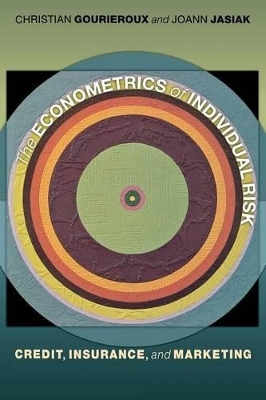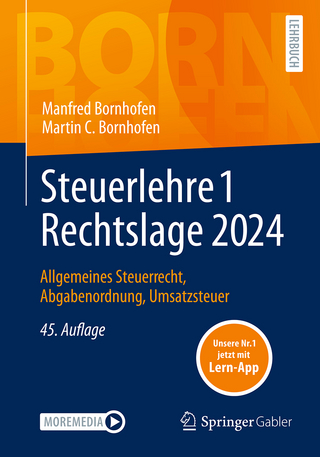
The Econometrics of Individual Risk
Princeton University Press (Verlag)
978-0-691-16821-0 (ISBN)
The book will interest graduate students in economics, business, finance, and actuarial studies, as well as actuaries and financial analysts.
Christian Gourieroux is Director of the Laboratory for Finance and Insurance at the Center for Research in Economics and Statistics (CREST) in Paris, and Professor at the University of Toronto. He is the coauthor of Statistics and Econometric Models, Simulation-Based Econometric Methods, and Time Series and Dynamic Models. Joann Jasiak is Associate Professor of Economics at York University, Toronto. She and Christian Gourieroux are the authors of Financial Econometrics (Princeton).
Preface xi Chapter 1: Introduction 1 1.1 Market Risk and Individual Risk 1 1.2 Risk Variable 2 1.3 Scores 3 1.4 Organization of the Book 4 References 5 Chapter 2: Dichotomous Risk 7 2.1 Risk Prediction and Segmentation 7 2.1.1 Risk Prediction 8 2.1.2 Segmentation 11 2.2 Econometric Models 14 2.2.1 Discriminant Analysis 14 2.2.2 Dichotomous Qualitative Models 15 2.2.3 Comparison of Discriminant and Logit Models 18 2.3 Risk Heterogeneity 19 2.4 Concluding Remarks 20 2.5 Appendix: The Logistic Distribution 20 References 21 Chapter 3: Estimation 23 3.1 Estimation Methods 23 3.1.1 The Maximum Likelihood Approach 23 3.1.2 Maximum Likelihood Estimation of a Logit Model 25 3.1.3 Maximum Likelihood Estimation in Linear Discriminant Analysis 27 3.1.4 Test of the Linear Discriminant Hypothesis 28 3.2 Significance Tests 29 3.2.1 Likelihood-Based Testing Procedures 30 3.2.2 Application of the LM Test to the Logit Model 31 3.3 Implementation 32 3.3.1 Development of Score Methodology 33 3.3.2 Mortgage Score 35 3.4 Concluding Remarks 39 References 40 Chapter 4: Score Performance 43 4.1 Performance and Selection Curves 43 4.1.1 Definitions 43 4.1.2 Desirable Properties of a Score 46 4.1.3 Comparison of Scores 47 4.2 Discriminant Curves 49 4.2.1 Definitions 50 4.2.2 Linear Discriminant Analysis 52 4.3 Demand Monitoring, Credit Granting, and Scores 52 4.3.1 Time-Varying Quality of Credit Applicants 53 4.3.2 Analysis of Credit-Granting Decision 55 4.3.3 Performance Curves 58 4.4 Concluding Remarks 58 4.5 Appendix: Positive Dependence 59 References 60 Chapter 5: Count Data Models 61 5.1 Poisson Regression 62 5.1.1 The Model 62 5.1.2 Maximum Likelihood Estimator 63 5.1.3 Relationship with the Dichotomous Qualitative Model 64 5.2 The Negative-Binomial Regression 64 5.2.1 Model with Gamma Heterogeneity 64 5.2.2 The Bonus-Malus Scheme 66 5.3 Semi-Parametric Analysis 69 5.3.1 Mean and Variance Estimators 70 5.3.2 Estimation of the Heterogeneity Distribution 71 5.3.3 Determination of the Premium 72 5.4 Applications 73 5.4.1 Car Insurance 73 5.4.2 Presentation of Results 77 5.5 Concluding Remarks 82 References 83 Chapter 6: Durations 85 6.1 Duration Distributions 86 6.1.1 Characterizations of a Duration Distribution 86 6.1.2 Duration Dependence 88 6.1.3 Basic Duration Distributions 89 6.2 Duration Models 92 6.2.1 The Exponential Regression Model 93 6.2.2 The Exponential Model with Gamma Heterogeneity 94 6.2.3 Heterogeneity and Negative Duration Dependence 95 6.3 Semi-Parametric Models 98 6.3.1 Accelerated Hazard Model 98 6.3.2 Proportional Hazard Model 99 6.4 Applications 100 6.4.1 Pension Fund 100 6.4.2 Interest Rate Spreads 101 6.4.3 Prepayment Analysis 103 6.5 Concluding Remarks 107 6.6 Appendix 109 6.6.1 Expected Residual Lifetime 109 6.6.2 Computation of the Premium Rate for the Pension Contract 110 References 111 Chapter 7: Endogenous Selection and Partial Observability 113 7.1 Analysis of Dichotomous Risks from a Stratified Sample 113 7.1.1 Description of the Population and the Sample 113 7.1.2 Exogenous Stratification 115 7.1.3 Endogenous Stratification 115 7.1.4 The Role of Stratified Samples 117 7.2 Truncation and Censoring in Duration Models 117 7.2.1 Censoring 117 7.2.2 Truncation 118 7.2.3 Competing Risks 119 7.3 Bias Correction Using Rejected Credit Applications 120 7.3.1 Selectivity Bias 120 7.3.2 Boundaries for Risk Prediction 121 7.3.3 A Bivariate Model for Bias Correction 122 7.4 Concluding Remarks 126 7.5 Appendix: First-Order Expansion of the C.D.F. of a Bivariate Normal Distribution 126 References 126 Chapter 8: Transition Models 129 8.1 Homogeneous Markov Chains 130 8.1.1 Distribution of the Markov Chain 130 8.1.2 Alternative Parametrizations of a Markov Chain 132 8.1.3 Two-State Space 134 8.1.4 Qualitative Representation of the Process 135 8.1.5 Estimation 136 8.2 Explanatory Variables 137 8.2.1 Specification of the Transition Probabilities 138 8.2.2 Specification of the Adjustment and Long-Run Parameters 138 8.2.3 Time-Dependent Markov Chain 139 8.3 Transitions between Score Categories 140 8.3.1 Revolving Consumer Credit 140 8.3.2 Corporate Rating Dynamics 143 8.4 Concluding Remarks 146 References 146 Chapter 9: Multiple Scores 149 9.1 Examples 150 9.1.1 Default Risk and Preselection 150 9.1.2 Term Structure of Default 151 9.1.3 Differentiated Incident Severity 152 9.1.4 Default and Prepayment 154 9.1.5 Default and Credit Promotion 156 9.1.6 Polytomous Logit Model 157 9.1.7 The Hypothesis of Irrelevant Alternatives 158 9.2 Profit- (Utility-) Optimizing Decisions 159 9.2.1 Promotional Mailing Decisions 159 9.2.2 Time-to-Default 161 9.2.3 Utility-Maximizing Behavior 162 9.3 Multi-Score Reduction Technique 163 9.3.1 Basic Notions 163 9.3.2 Singular Value Decomposition (SVD) 164 9.3.3 Statistical Inference 165 9.4 Household Portfolio Allocation 166 9.4.1 Description of the Data Set 166 9.4.2 Model Estimation 169 9.4.3 Reduction of the Number of Scores 176 9.5 Concluding Remarks 178 References 179 Chapter 10: Serial Dependence in Longitudinal Data 181 10.1 Poisson and Compound Poisson Processes 182 10.1.1 Poisson Process 182 10.1.2 Compound Poisson Process 184 10.1.3 From Discrete Time to Continuous Time 185 10.2 Models with Serial Dependence 186 10.2.1 Autoregressive Models 188 10.2.2 Time-Dependent Heterogeneity 192 10.3 Applications 195 10.3.1 Cost Sensitivity with Respect to Transitory Shocks 195 10.3.2 Learning in Revolving Credit 197 10.4 Concluding Remarks 205 10.5 Appendix: Distributions of the Duration and Count Variables 205 10.5.1 Distribution of the First Duration 205 10.5.2 Independence of Durations 206 10.5.3 Distribution of the Count Variable 206 References 206 Chapter 11: Management of Credit Risk 209 11.1 Measures of Risk and Capital Requirement 209 11.1.1 Value-at-Risk 210 11.1.2 Properties of a Risk Measure 212 11.2 Credit Portfolio 213 11.2.1 The P&L Distribution for a Credit Portfolio When the Horizon Is Equal To the Maturity 214 11.2.2 The P&L Distribution for a Credit Portfolio When the Horizon Is Shorter Than the Maturity 216 11.3 Corporate Bond Portfolio 223 11.3.1 Informational Content of Bond Prices 223 11.3.2 Default Correlation 224 11.3.3 Stochastic Transition Model 230 11.4 Concluding Remarks 235 References 235 Index 239
| Verlagsort | New Jersey |
|---|---|
| Sprache | englisch |
| Maße | 152 x 235 mm |
| Gewicht | 369 g |
| Themenwelt | Wirtschaft ► Betriebswirtschaft / Management ► Finanzierung |
| Wirtschaft ► Betriebswirtschaft / Management ► Marketing / Vertrieb | |
| Wirtschaft ► Volkswirtschaftslehre ► Ökonometrie | |
| ISBN-10 | 0-691-16821-0 / 0691168210 |
| ISBN-13 | 978-0-691-16821-0 / 9780691168210 |
| Zustand | Neuware |
| Haben Sie eine Frage zum Produkt? |
aus dem Bereich


